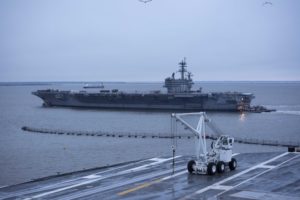A top Navy official last month said the service is reexamining the current carrier strike group readiness generation model because it may no longer fit today’s realities.
“We recognize that we have to take a good hard look at it. We started that look last July and Admirals Grady and Aquilino, the two fleet commanders in the Atlantic and Pacific, owe CNO an answer on that here in the coming months,” Vice Chief of Naval operations Adm. Robert Burke said Oct. 25.

“We understand why the carriers are in the situation they are. And OFRP was designed – the O in OFRP stands for optimized but it was optimized in 2012, around some different objectives,” Burke said at a Military Reporters and Editors conference.
The Optimized Fleet Response Plan (OFRP), first instituted in 2014, aims to maximize ship employability for combatant commanders as well as increasing readiness and preserving maintenance and training.
OFRP for aircraft carriers has a 36-month cycle that have six to seven months of maintenance work, six months of basic and integrated training, a primary deployment of seven months, and then a sustainment phase lasting up to 14.5 months where the ship could deploy a second time if needed.
However, the shipyards that maintain carriers have been busy with submarine and carrier repair work so maintenance availabilities get expanded, pushing several ships out of the OFRP.
Four carriers are currently out of the OFRP cycle. The USS Gerald R. Ford (CVN-78) finished its post-shakedown availability but will still go through shock trials and a maintenance/certification period for first in class ships before its initial deployment. The USS George H.W. Bush (CVN-77) is undergoing a maintenance availability that is taking 28 rather than 10.5 months due to yard capacity.
Moreover, the USS John C. Stennis (CVN-74) and George Washington (CVN-73) are going into their mid-life refueling and complex overhaul periods.
Currently, only two carriers are deployed: the USS Ronald Reagan (CVN-76), which is forward deployed to Japan, and the Abraham Lincoln (CVN-72), which is being extended past its planned seven months. Lincoln would likely otherwise be replaced by the Harry S. Truman (CVN-75), but that carrier is undergoing repairs due to “very unique problems” with electrical systems, Burke said.
Burke added Truman is on a path to recovery and “she’ll be up and operating soon. I don’t have the exact date or timeline for it but it’s weeks not months.”
Burke said having six carriers in various state of repair or maintenance is an example of “how these cascading effects over the last eight to 10 years of using up that surge readiness and not keeping up with the maintenance and it all sort of piled up, so it’s where we are.”
Burke said the Navy is “very open to making changes to that readiness plan and we’ve taken it down to the fundamental assumptions and principles of it and what do we have to do differently to look at it.”
He said the Navy is talking about the OFRP with the rest of the Joint Staff and the Secretary of Defense.
“They all understand how we got here, but they’re working with us to do it better going forward. And part of that is you can’t use up that wartime capacity for things short of war and wish you had it when you need it later. So we’re going to have to do a little bit of an appetite suppressant on how many carriers we’re able to provide,” Burke said.
He acknowledged carriers are in high demand and no combatant commander would not say they do not need one or more carriers.
“But how do we improve the availability? Part of it will be these maintenance actions, the overhauls that we’re doing and the processes in getting more efficient there. And then, if we can come up with a different operating model to generate that readiness more efficiently, we’ll definitely be looking at that hard.”